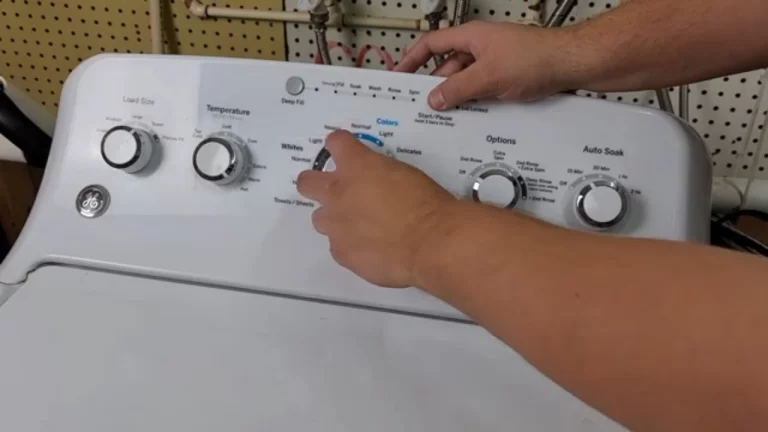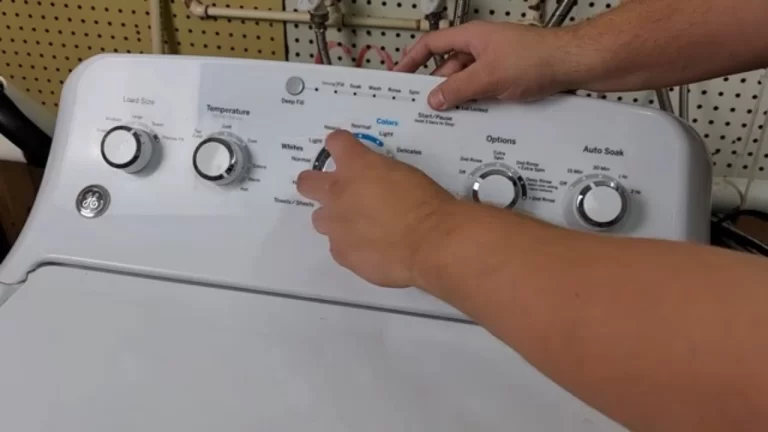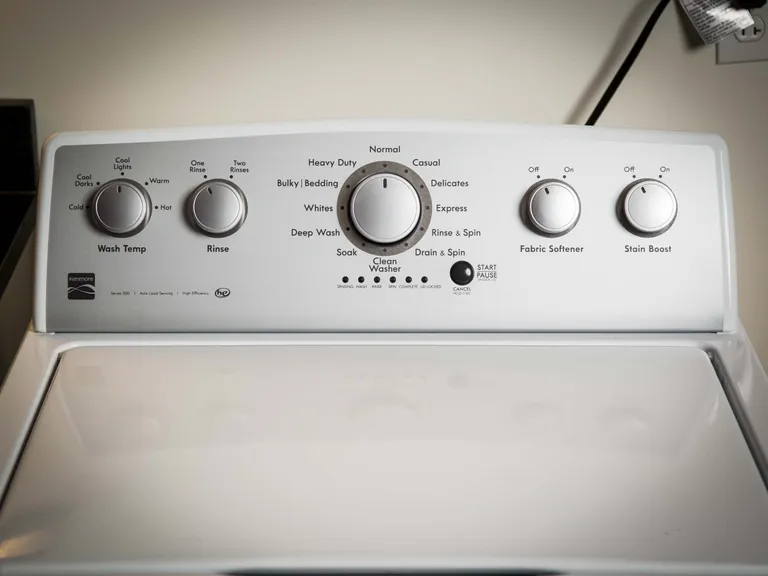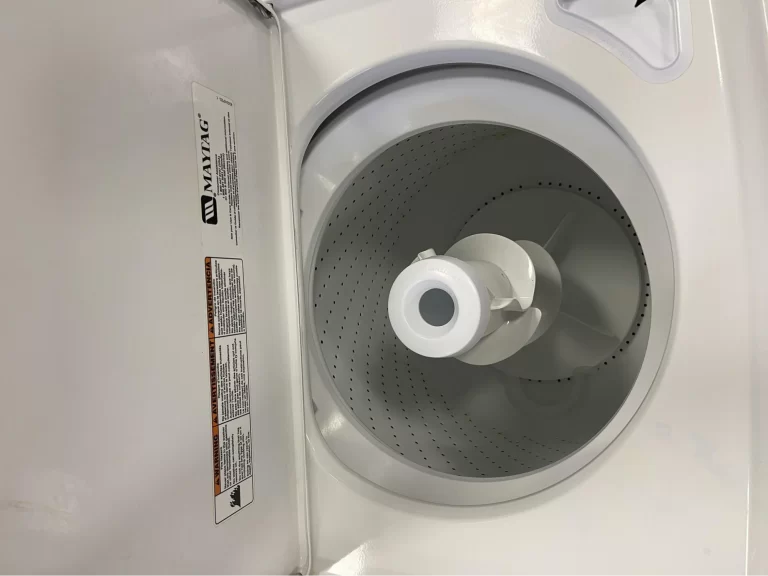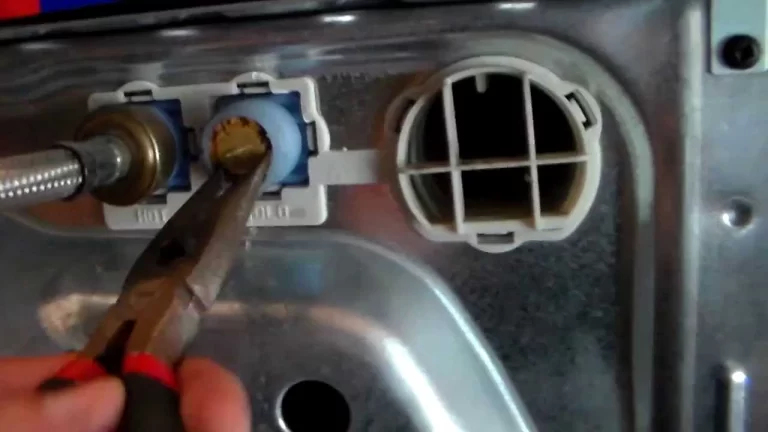Experiencing a noisy, shaky spin cycle with your GE washer? This issue, though common, can be quite disruptive. But fret not! This article will walk you through the common causes for this, including overloading, uneven distribution of clothes, an unleveled machine, and even damaged parts. But it doesn’t stop there; we’ll also guide you on how to diagnose these issues and provide easy, do-it-yourself fixes. Get ready to transform your laundry routine into a quiet, efficient process once again with this comprehensive guide.
If your GE washer is out of balance during the spin cycle, it could be due overloading or underloading, uneven distribution of clothes, an unleveled machine, or worn suspension parts could cause the issue. Addressing these problems or replacing faulty components like the lid switch, load sensor, drain pump, or drive belt can help restore balance.
Quick troubleshooting guide
| Issue | Symptom | Fix |
| Overloading/Underloading | Excessive vibration or loud noise during spin cycle | Adjust load size. The drum should be about three-quarters full |
| Uneven Distribution of Clothes | Unbalanced washer during spin cycle | Manually redistribute the clothes evenly around the drum |
| Unleveled Washer | Washer “walking” during spin cycle | Use a level to check and adjust the washer’s feet |
| Worn/Damaged Suspension Parts | Increased shaking or loud noises | Check and replace worn suspension rods and springs |
| Faulty Load Sensing | Washer isn’t filling correctly | Reset the washer. If issue persists, replace load sensor |
| Faulty Lid Switch | Washer won’t spin or stops mid-cycle | Check and replace damaged lid switch |
| Clogged Drain Pump | Washer isn’t draining correctly | Check and clear obstruction in drain pump |
| Drive Belt Issues | Washer isn’t spinning, but fills and drains water | Check and replace damaged drive belt |
Understanding the GE Washer’s Spin Cycle

The spin cycle is a crucial stage in the washing process, ensuring that your clothes come out of the washer with minimal moisture. To appreciate why balance is so important during this phase, it’s necessary to delve a little deeper into what exactly happens during a GE Washer’s spin cycle.
The primary function of the spin cycle is to extract water from your clothes. Once the washing phase is complete, the washer drum spins at high speeds, typically between 800 to 1800 revolutions per minute (RPM) in modern GE models. The exact speed varies depending on the specific model and the chosen settings.
This rapid spinning creates a strong centrifugal force. The force pushes the water in your clothes outwards and into the drain. For this process to be efficient, the distribution of clothes (and, therefore, the load) within the drum needs to be as uniform as possible. This even distribution helps maintain the balance of the drum as it spins.
If the load is uneven, the weight distribution during the spin cycle will be imbalanced. This imbalance can cause the drum to wobble or oscillate significantly. Such oscillations can lead to excessive vibrations, which you may perceive as the washer “dancing” or making loud noises.
According to a report by the Consumer Product Safety Commission, these vibrations can potentially lead to premature wear and tear of the washer components, reduce the machine’s effectiveness, and in extreme cases, even cause the machine to move or “walk.”
In a nutshell, the spin cycle of your GE Washer plays an essential role in the efficiency of your laundry routine. Understanding it is the first step towards diagnosing and rectifying the imbalance issues. This knowledge can help extend your washer’s lifespan, enhance its performance, and ensure a smoother, quieter laundry process.
How to Diagnose a Noisy and Out-of-Balance GE Washer
A noisy and out-of-balance GE washer can disrupt your peaceful home environment and also affect the efficiency of your laundry routine. Diagnosing the cause of the problem is the first step to resolving it. Here’s a guide on how to do it:
Step 1: Check the Load Size and Distribution
First, examine the load size and distribution of clothes in the drum. Overloading or underloading the washer or an uneven distribution of clothes can cause imbalance and create noise during the spin cycle. If you observe that the washer is either overloaded or underloaded, adjust the load size. The drum should be about three-quarters full. If the clothes are not distributed evenly, redistribute them manually.
Step 2: Inspect the Level of the Washer
A washer that’s not level can also cause noise and balance issues. Using a spirit level, check if your washer is leveled correctly. It should be level both from front to back and side to side. Adjust the feet as necessary until the washer is level, and make sure to tighten the locknuts on the washer’s feet to ensure they stay in place.
Step 3: Examine the Suspension Parts
The suspension system absorbs the movement of the drum. If these components are worn or damaged, it could lead to increased vibration and noise. Inspect the suspension rods and springs for any signs of wear or damage. If any parts are damaged, they’ll need replacement.
Step 4: Investigate the Load Sensor and Lid Switch
Modern washers have automatic load sensing and a lid switch for safety. If either of these is faulty, it could lead to balance issues. Run a cycle with a small load and see if the washer fills correctly. If not, the load sensor might need replacement. Similarly, if the washer doesn’t spin or stops mid-cycle, the lid switch might be faulty.
Step 5: Check the Drain Pump and Drive Belt
A clogged drain pump or a worn-out drive belt can also cause balance issues. Check for any obstructions in the drain pump. If it’s clogged, clear it out. Also, examine the drive belt for signs of wear. If it’s frayed or burnt, it’ll need to be replaced.
By following these steps, you can diagnose why your GE washer is noisy and out of balance. Remember, when dealing with electrical appliances, safety should be your priority. If you’re not comfortable diagnosing or fixing an issue yourself, always call a professional.
Common Problems With GE washer being out of balance during the spin cycle

1. Uneven Distribution of Clothes
Symptom: The washer is unbalanced during the spin cycle, resulting in excess noise or movement.
This usually occurs when clothes bunch up on one side of the drum during a wash cycle. Since the weight is not evenly distributed, it can lead to unbalanced spinning, causing your washer to vibrate excessively or even “walk.”
Fix:
- Step 1: Pause the washing machine.
- Step 2: Open the washer door and manually redistribute the clothes evenly around the drum.
- Step 3: Close the door and resume the cycle.
2. Unleveled Washer
Symptom: The washer is “walking,” or moving around during the spin cycle.
If your washer isn’t level, it can cause the machine to vibrate more than usual or even move during the spin cycle. The four feet at the bottom of your washer should be in firm contact with the floor.
Fix:
- Step 1: Pause the washer and unload any laundry from the drum.
- Step 2: Use a spirit level to check whether the washer is leveled correctly.
- Step 3: Adjust the feet as necessary until the washer is level both front-to-back and side-to-side.
- Step 4: Tighten the lock nuts on the washer’s feet to ensure they stay in place.
3. Worn or Damaged Suspension Parts
Symptom: Even with a balanced load, the washer is shaking or making loud noises.
The suspension system in your washer absorbs the movement of the drum. Over time, these components can wear out or become damaged, reducing their effectiveness and resulting in increased vibration during the spin cycle.
Fix:
- Step 1: Unplug the washer.
- Step 2: Check the suspension rods and springs. You may need to remove the top or front panel of your washer to access these parts.
- Step 3: Look for signs of wear, such as sagging springs or rods that don’t rebound when pushed.
- Step 4: If any parts are damaged, replace them with new ones compatible with your washer model.
4. Faulty Load Sensing
Symptom: The washer isn’t filling correctly, which could lead to an unbalanced load.
Most modern washers have automatic load sensing technology to fill the appropriate amount of water based on the load size. If the load sensor is faulty, the washer may not fill correctly, leading to potential balance issues during the spin cycle.
Fix:
- Step 1: Try resetting the washer by unplugging it for about one minute, then plugging it back in.
- Step 2: Run a cycle with a small load to see if the problem persists.
- Step 3: If the issue continues, the load sensor may need replacement. Consider calling a professional technician to replace the sensor, as this process involves dealing with electrical components.
5. Faulty Lid Switch
Symptom: The washer won’t spin or may stop mid-cycle.
The lid switch signals the washer that the lid is closed, and it’s safe to spin. If the switch is faulty, the washer may not spin at all, or it could stop mid-cycle, causing an imbalance in the load.
Fix:
- Step 1: Check the lid switch for any visible signs of damage.
- Step 2: If the switch doesn’t click when you press it, or it’s visibly broken, it will need replacement.
- Step 3: Unplug the washer and remove the lid switch according to the instructions in your washer’s manual.
- Step 4: Install the new lid switch and ensure it’s working correctly by running a test cycle.
6. Clogged Drain Pump
Symptom: The washer isn’t draining correctly or is leaving clothes too wet after the spin cycle.
The drain pump removes water from the washer during the drain and spin cycles. If it’s clogged with small clothing items, coins, or lint, it can prevent the washer from draining properly, leading to excessively wet clothes and potential balance issues.
Fix:
- Step 1: Unplug the washer and locate the drain pump. This is typically on the bottom of the washer and can be accessed by removing a panel.
- Step 2: Check for any obstructions in the pump or connecting hoses. You may need to remove the pump to do this thoroughly.
- Step 3: If you find an obstruction, clear it, then reinstall the pump.
- Step 4: Run a spin cycle to check if the washer is draining properly.
7. Drive Belt Issues
Symptom: The washer isn’t spinning, but it’s still filling with water and draining.
The drive belt connects the motor to the drum. If it’s broken or worn out, the drum won’t spin, even though the washer can still fill and drain.
Fix:
- Step 1: Unplug the washer and locate the drive belt at the bottom of the machine.
- Step 2: Check the belt for signs of wear, such as fraying or burning.
- Step 3: If the belt is damaged, remove it by sliding it off the pulleys.
- Step 4: Install a new drive belt by fitting it around the pulleys, then turning the pulleys until the belt is securely in place.
Preventive Measures for Washing Machine Care
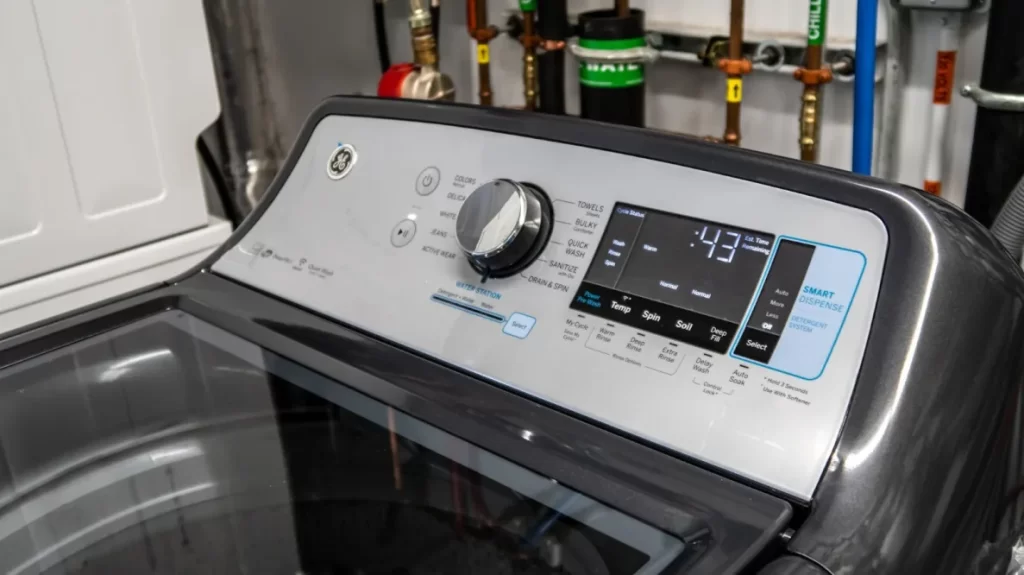
To avoid future washer imbalance issues, take these preventive steps:
- Correct Loading: Always ensure your load size is suitable for your washer’s capacity. The clothes should be evenly distributed inside the drum.
- Routine Maintenance: Regularly inspect your washer for signs of wear and tear, particularly on the suspension parts.
- Be Vigilant: Pay attention to the sounds your washer makes. Unusual noises might indicate potential problems.
FAQs
How can I determine the correct load size for my GE Washer?
Refer to your washer’s user manual for specific load size recommendations. Generally, avoid filling the drum more than three-quarters full for regular loads. This allows enough space for clothes to move freely during the wash and spin cycles.
How often should I inspect the suspension parts of my GE washer?
It’s a good practice to inspect the suspension parts at least once a year or whenever you start noticing excessive noise or vibrations during the spin cycle.
My GE washer is showing an error code during the spin cycle, what does it mean?
GE washers display different error codes for various issues. Refer to your washer’s user manual to interpret the specific code. If you’re unsure or the problem persists, it might be best to call a professional for assistance.
I’ve tried troubleshooting but my washer is still unbalanced. What should I do?
If your washer continues to be unbalanced despite troubleshooting, it’s likely time to call a professional. Some issues, especially those related to internal components, might require expert attention.
What can I do to prevent my GE washer from becoming unbalanced in the future?
Regular maintenance and correct usage are key. This includes loading the washer properly, regularly checking for worn or damaged parts, ensuring the machine is level, and watching for early warning signs of imbalance, such as unusual noises or excessive vibrations.
Conclusion
With the detailed knowledge you’ve gained from this guide, you are now well-equipped to tackle a GE washer that’s out of balance during the spin cycle. By recognizing and addressing the root causes effectively, you can ensure a smoother and quieter laundry experience. Remember, preserving your washer’s balance is crucial for its longevity and optimum performance. You’re now empowered to handle this issue with confidence, ensuring a tranquil home environment and efficient laundry routine.

